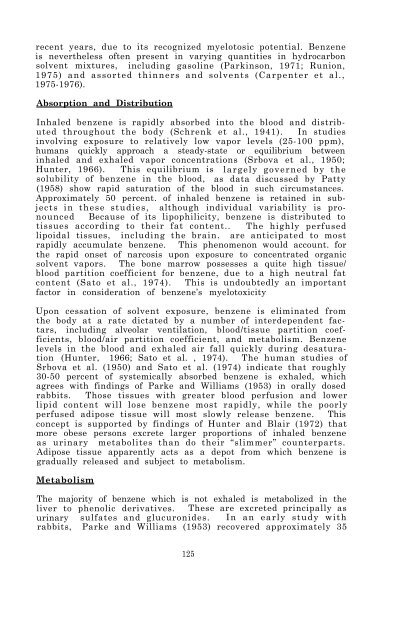Review of Inhalants - ARCHIVES - National Institute on Drug Abuse
Review of Inhalants - ARCHIVES - National Institute on Drug Abuse
Review of Inhalants - ARCHIVES - National Institute on Drug Abuse
Create successful ePaper yourself
Turn your PDF publications into a flip-book with our unique Google optimized e-Paper software.
ecent years, due to its recognized myelotosic potential. Benzene<br />
is nevertheless <str<strong>on</strong>g>of</str<strong>on</strong>g>ten present in varying quantities in hydrocarb<strong>on</strong><br />
solvent mixtures, including gasoline (Parkins<strong>on</strong>, 1971; Runi<strong>on</strong>,<br />
1975) and assorted thinners and solvents (Carpenter et al.,<br />
1975-1976).<br />
Absorpti<strong>on</strong> and Distributi<strong>on</strong><br />
Inhaled benzene is rapidly absorbed into the blood and distributed<br />
throughout the body (Schrenk et al., 1941). In studies<br />
involving exposure to relatively low vapor levels (25-100 ppm),<br />
humans quickly approach a steady-state or equilibrium between<br />
inhaled and exhaled vapor c<strong>on</strong>centrati<strong>on</strong>s (Srbova et al., 1950;<br />
Hunter, 1966). This equilibrium is largely governed by the<br />
solubility <str<strong>on</strong>g>of</str<strong>on</strong>g> benzene in the blood, as data discussed by Patty<br />
(1958) show rapid saturati<strong>on</strong> <str<strong>on</strong>g>of</str<strong>on</strong>g> the blood in such circumstances.<br />
Approximately 50 percent. <str<strong>on</strong>g>of</str<strong>on</strong>g> inhaled benzene is retained in subjects<br />
in these studies, although individual variability is pr<strong>on</strong>ounced<br />
Because <str<strong>on</strong>g>of</str<strong>on</strong>g> its lipophilicity, benzene is distributed to<br />
tissues according to their fat c<strong>on</strong>tent.. The highly perfused<br />
lipoidal tissues, including the brain. are anticipated to most<br />
rapidly accumulate benzene. This phenomen<strong>on</strong> would account. for<br />
the rapid <strong>on</strong>set <str<strong>on</strong>g>of</str<strong>on</strong>g> narcosis up<strong>on</strong> exposure to c<strong>on</strong>centrated organic<br />
solvent vapors. The b<strong>on</strong>e marrow possesses a quite high tissue/<br />
blood partiti<strong>on</strong> coefficient for benzene, due to a high neutral fat<br />
c<strong>on</strong>tent (Sato et al., 1974). This is undoubtedly an important<br />
factor in c<strong>on</strong>siderati<strong>on</strong> <str<strong>on</strong>g>of</str<strong>on</strong>g> benzene’s myelotoxicity<br />
Up<strong>on</strong> cessati<strong>on</strong> <str<strong>on</strong>g>of</str<strong>on</strong>g> solvent exposure, benzene is eliminated from<br />
the body at a rate dictated by a number <str<strong>on</strong>g>of</str<strong>on</strong>g> interdependent factars,<br />
including alveolar ventilati<strong>on</strong>, blood/tissue partiti<strong>on</strong> coefficients,<br />
blood/air partiti<strong>on</strong> coefficient, and metabolism. Benzene<br />
levels in the blood and exhaled air fall quickly during desaturati<strong>on</strong><br />
(Hunter, 1966; Sato et al. , 1974). The human studies <str<strong>on</strong>g>of</str<strong>on</strong>g><br />
Srbova et al. (1950) and Sato et al. (1974) indicate that roughly<br />
30-50 percent <str<strong>on</strong>g>of</str<strong>on</strong>g> systemically absorbed benzene is exhaled, which<br />
agrees with findings <str<strong>on</strong>g>of</str<strong>on</strong>g> Parke and Williams (1953) in orally dosed<br />
rabbits. Those tissues with greater blood perfusi<strong>on</strong> and lower<br />
lipid c<strong>on</strong>tent will lose benzene most rapidly, while the poorly<br />
perfused adipose tissue will most slowly release benzene. This<br />
c<strong>on</strong>cept is supported by findings <str<strong>on</strong>g>of</str<strong>on</strong>g> Hunter and Blair (1972) that<br />
more obese pers<strong>on</strong>s excrete larger proporti<strong>on</strong>s <str<strong>on</strong>g>of</str<strong>on</strong>g> inhaled benzene<br />
as urinary metabolites than do their “slimmer” counterparts.<br />
Adipose tissue apparently acts as a depot from which benzene is<br />
gradually released and subject to metabolism.<br />
Metabolism<br />
The majority <str<strong>on</strong>g>of</str<strong>on</strong>g> benzene which is not exhaled is metabolized in the<br />
liver to phenolic derivatives. These are excreted principally as<br />
urinary sulfates and glucur<strong>on</strong>ides. In an early study with<br />
rabbits, Parke and Williams (1953) recovered approximately 35<br />
125
















